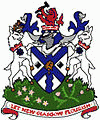New Glasgow (New Glasgow)
 |
The town's population was 9,075 in the 2016 census. New Glasgow is at the centre of the province's fourth largest urban area; the population of the New Glasgow census agglomeration in the 2016 census was 34,487. The New Glasgow census agglomeration includes the smaller adjacent towns of Stellarton, Westville, and Trenton as well as adjacent rural areas of the county.
Scottish immigrants, including those on the ship Hector in 1773, settled the area of the East River of Pictou during the late 18th and early 19th centuries.
Deacon Thomas Fraser first settled the area at the head of navigation on the East River of Pictou in 1784. The settlement was officially named "New Glasgow", after Glasgow in Scotland, in 1809, the same year its first trading post was developed.
The discovery of large coal deposits in the East River valley during the early 19th century saw New Glasgow, at the head of navigation, quickly develop into a manufacturing and port community.
In 1829, a horse-drawn tramway was built using standard gauge rails from the settlement of Albion Mines (now Stellarton) to a wharf near New Glasgow. This was the first use of standard gauge rails in what would become Canada. On September 19, 1839, the Albion Railway was opened from Albion Mines to New Glasgow, hauling coal wagons behind steam locomotives such as the Samson along the west bank of the East River of Pictou. This was the second steam-powered railway in what would become Canada, and the first to use iron rails. The railway was extended north to a coal loading pier at Dunbar's Point on May 14, 1840.
In 1840, George MacKenzie started the town's first shipbuilding company, which eventually built or owned 34 vessels; hundreds of ships would later be built along the East River in New Glasgow.
In June 1867, the Nova Scotia Railway opened its "Eastern Line" from Truro through New Glasgow to its terminus at the passenger and cargo wharf in Pictou Landing. In 1882 the "Eastern Extension" of the Intercolonial Railway was opened from New Glasgow to Mulgrave on the Strait of Canso, placing New Glasgow on the mainline between Cape Breton Island and the North American rail network.
Economic development in New Glasgow was driven by the steel industry in neighbouring Trenton (site of the first steel manufacturing in Canada), shipbuilding and shipping in Pictou and Pictou Landing, and coal mining in Stellarton and Westville.
After World War I, the famous New York sculptor J. Massey Rhind was commissioned to make the Nova Scotia Highlander soldier cenotaph. In 1946, New Glasgow was the setting for an important civil rights case when Viola Desmond challenged racial segregation of New Glasgow's Roseland Theatre. New Glasgow became a service centre for the county during the late 20th century as shopping centres, retail and residential development was spurred by the construction of Highway 104.
Map - New Glasgow (New Glasgow)
Map
Country - Canada
 |
 |
| Flag of Canada | |
Indigenous peoples have continuously inhabited what is now Canada for thousands of years. Beginning in the 16th century, British and French expeditions explored and later settled along the Atlantic coast. As a consequence of various armed conflicts, France ceded nearly all of its colonies in North America in 1763. In 1867, with the union of three British North American colonies through Confederation, Canada was formed as a federal dominion of four provinces. This began an accretion of provinces and territories and a process of increasing autonomy from the United Kingdom. This widening autonomy was highlighted by the Statute of Westminster 1931 and culminated in the Canada Act 1982, which severed the vestiges of legal dependence on the Parliament of the United Kingdom.
Currency / Language
| ISO | Currency | Symbol | Significant figures |
|---|---|---|---|
| CAD | Canadian dollar | $ | 2 |
| ISO | Language |
|---|---|
| EN | English language |
| FR | French language |
| IU | Inuktitut |















